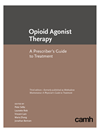Text adapted in 2023 from "Opioid Use and Opioid Use Disorders" in The Primary Care Addiction Toolkit. Revised version available online only.
Purpose of urine drug testing
Urine drug testing (UDT) can help to confirm a diagnosis of opioid use disorder. It is also a therapeutic tool that monitors adherence and response to opioid agonist treatment and checks for ongoing illicit substance use (Centre for Effective Practice, 2018b). Urine drug tests can provide important clinical information:
- The absence of a prescribed drug could indicate diversion or non-compliance.
- The presence of an illegal drug indicates ingestion of that substance and a possible substance use problem.
- The presence of a non-prescribed opioid could indicate double-doctoring or use of diverted opioids.
Clinical guidelines (Centre for Addiction and Mental Health [CAMH], 2021) recommend using UDT:
- when initiating OAT
- when adjusting doses during stabilization
- when there is concern about a patient’s presentation
- when the patient requests it.
Explain to patients that UDT is not a punitive tool, but that it can provide information to help assess and manage risks, guide treatment decisions and monitor the patient’s progress. Discuss UDT results with the patient, including possible explanations if test findings differ from what the patient reports.
Consider regular UDT for all patients on opioid agonist therapy (CAMH, 2021). The frequency depends on the stage of treatment and on the patient’s stability. Unscheduled UDT may also be useful in some situations.
Types of UDT
Two types of UDT are used for clinical purposes:
- Immunoassay identifies the presence of substances in the urine based on a detection threshold. This means that a test result is positive if there is enough of a drug or its metabolite in the urine to react with a predetermined threshold of antibodies in the assay. Immunoassays are often used at the point of care as a baseline test. They cannot differentiate between opioids, with the exception of oxycodone and fentanyl, which are available as separate tests. Immunoassays often do not detect semi-synthetic or synthetic opioids (e.g., oxycodone, methadone, fentanyl).
- Chromatography is more sensitive and specific than immunoassay. It confirms the results of immunoassays and is able to detect more substances than an immunoassay. Chromatography separates substances into its components and identifies those parts. It can differentiate among opioids (e.g., codeine, morphine, methadone) and is also more accurate for semi-synthetic and synthetic opioids.
Window of detection for different classes of drugs
The window of detection refers to the range of time in which a specific substance can be detected in a urine sample. The detection window for a particular drug depends on several factors, including the half-life of parent drugs and metabolites, and lipophilicity. Typical drug detection windows are listed below (Selby et al., 2022). There may be slight variations in the literature. These windows may be prolonged, depending on the amount ingested and on whether drug use is heavy or occasional:
- opiates: 2–3 days
- methadone: 4–5 days
- benzodiazepines: 1–42 days
- cocaine/metabolites: 2–4 days
- THC single use: 2–3 days
- THC habitual use: up to 12 weeks
- methamphetamine: 3–5 days
- alcohol: 6–24 hours
Preparing for UDT
Prior to UDT, ask patients for a detailed history of their medication use over the preceding several hours and days. Ask, for example, whether the patient took their opioid medication that morning. Ask about any recent illicit substance use that may be detected by UDT. Also ask the patient how long before the UDT they took their medication because this helps to interpret UDT results.
Always inform patients that you are collecting a urine sample for UDT and obtain their consent. UDT should be included in the treatment agreement, if you have one.
Clinical experience suggests that patients accept UDT more readily if it is part of routine care, rather than being used only when the clinician suspects illicit substance use.
Interpreting UDT
Diagnoses and treatment decisions must be based on a careful assessment because a single UDT result can be misleading. An unexpected result is not in itself sufficient to make a diagnosis of opioid use disorder or to determine that a patient is not adhering to treatment.
For example, the absence of a prescribed opioid does not necessarily mean that the patient is diverting the opioid. The result could be a false negative; the patient may have run out of the medication a few days before the test; or the patient may not have been taking their doses and did not want to tell you.
It may also be that the UDT is not able to detect that particular opioid. For example, opioid results may be negative in a patient who has ingested fentanyl.
To interpret UDT results accurately, clinicians need to understand metabolic pathways and the sensitivity, specificity, positive and negative predictive values and limitations of UDT (CAMH, 2021). Consider the following factors when clinically interpreting UDT:
- analytical principles, benefits and limitations of drug-testing methodologies
- specifics of individual immunoassays: assay type, cut-offs and cross-reactivity data
- drug metabolites as markers of substance use: major vs. minor metabolites, excretion patterns, detection windows
- potential causes for inconsistent, anomalous or unexpected UDT results
- new trends for drugs of abuse (novel psychoactive substances) and laboratory capacity for detection
- tampering techniques, how they affect UDT results and how to use specimen validity tests to minimize and detect tampering.
The Centre for Effective Practice (2018b) provides guidance on interpreting UDT results in the context of these factors.


